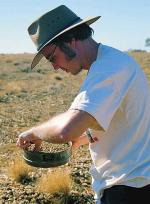'Weird' fossil find excites researchers
 Environmental Biology Environmental Biology
Scientists from the South Australian Museum and the University of Adelaide have uncovered an unexpectedly rich fossil deposit in the arid grasslands near Boulia in western Queensland. Researchers were furthering work on ancient turtle fossils when they revealed the deposit. Palaeontologist Dr Ben Kear from the Museum and the University's School of Earth and Environmental Sciences said the extent of prehistoric fossil material found was far greater than could possibly have been hoped for. "As well as twelve fossil turtles we have found the remains of numerous ichthyosaurs, sharks, fragments of an armoured dinosaur and, most excitingly, a possible new species of long-necked plesiosaur," Dr Kear said. "The plesiosaur is especially exciting because it has an unusual arrangement of teeth - in fact it
is weird enough for us to question its origins. "Long-necked plesiosaurs typically have teeth that stretch the whole length of the jaw, but the new specimen we have uncovered has all its teeth bunched at the front of the mouth. "The fossil will take some 12 months of careful preparation with acid to determine if it is a known species or definitely something entirely new." Dr Kear said the significant finds in Queensland would assist with ongoing research into fossils from the ancient inland sea that once covered much of Australia during the Early Cretaceous period - the last stage of what is commonly called the "age of dinosaurs". New fossil turtle specimens also recovered on the trip will add new information to Dr Kear's research into what appears to be one of the most primitive ancestors of modern-day sea turtles. "These 110-million-year old fossils are the earliest remains of their kind found in Australia, and seem to be near the base of the modern sea turtle lineage," Dr Kear said. "The new material includes several articulated skeletons, some of which have gut contents that will allow us to determine the diet of these ancient creatures." Although most of the finds represent the remains of marine creatures, the team was lucky enough to recover the fragmentary remains of a terrestrial dinosaur. "The animal is an ankylosaur, a small, four-legged, plant eating dinosaur that was covered in an armour of small bony plates. These ankylosaurs were only about two to three metres long and around one metre tall. While not thought to be uncommon in its day, this is still only one of a handful of specimens to be found in Australia," Dr Kear said. "The ankylosaur probably died on land and was washed out to sea, coincidentally ending up with the remains of marine creatures."
|






